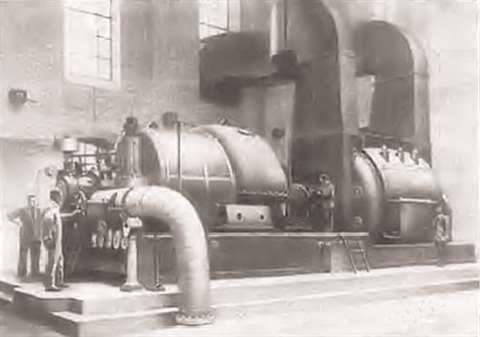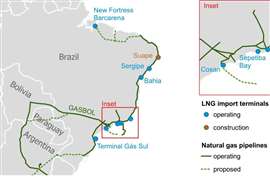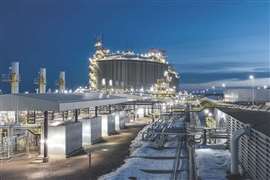Read this article in Français Deutsch Italiano Português Español
Cornerstones of Compression: Howden Rotary Screw Compressors
February 21, 2023
 Howden’s WRV line has seven frame sizes from 6.4 to 22.8 in. (163 to 580 mm) rotor diameter, each available with two to six rotor lengths. Shown here is one of the largest frame sizes.
Howden’s WRV line has seven frame sizes from 6.4 to 22.8 in. (163 to 580 mm) rotor diameter, each available with two to six rotor lengths. Shown here is one of the largest frame sizes.
The Howden Company originated in 1854, when James Howden founded a marine consulting engineering firm. In his first year in business, he secured a patent for improving rivet making, and a few years later had a patent for efficiency improvements for ship engines and boilers. In 1857, he began to design and supply boilers and steam engines for the marine industry.
In 1862, Howden built a factory in Glasgow, Scotland instead of subcontracting the work. Continuing to conceive new ideas for improving efficiency, he patented the “Howden forced draft” system in 1882 that resulted in ships being able to go twice as fast on half the amount of coal. More than a thousand ships were fitted with the new system in subsequent years.
Around 1880, the company couldn’t find a reliable source to manufacture the fans that it needed for the forced draft system, so it constructed another factory in Glasgow for that purpose. This location would be the main headquarters of the company for nearly a hundred years.
Around 1900, Howden began producing high-speed steam engines for generating electricity on land. Before long, large numbers of these units up to 2000 hp (1491 kW) were being installed for municipalities, factories and mills. The next logical development was steam turbines, which Howden began to manufacture in 1904.
In the early 1920s, Howden began a joint venture with the AB Ljungstrom Angturbin of Stockholm, Sweden, which had developed a new mechanical preheater. This was an important product that helped grow Howden’s large steam turbine business. An even more important development resulted from the association. Ljungstrom and its chief engineer, Alf Lysholm, had invented the first rotary screw compressor in 1935 for use in jet engines. In 1938, Howden became the first company to license and commercialize Ljunstrom’s (later Svenska Rotor Maskiner AB) screw compressor technology.
Howden became a public company in 1939. The success of the screw compressor product led to building the new Craigton factory in Glasgow in the early 1950s, entirely dedicated to the manufacture of rotary screw compressors. The first large industrial refrigeration plant using screw compressors, which included a total of 24,000 hp (17,897 kW) of Howden compressors, was purchased by the U.S.S.R in the 1950s. The first Howden screw compressor air conditioning units were installed in the ocean liner Queen Elizabeth.
In 1968, Howden acquired Godfrey Engineering, a manufacturer of smaller refrigeration and air compressors for the aircraft industry. This significantly expanded the scale and reach of Howden in the screw compressor industry. Also in the 1960s, Howden developed the oil-injected (aka oil-flooded) rotary twin screw compressor that revolutionized designs of refrigeration and gas handling plants worldwide. Oil-injection absorbed the heat of gas compression enabling higher pressure ratios, reduced noise, improved efficiency and greatly reduced rotor wear.
The Howden oil-injected compressors evolved into two lines. The WRV series uses shell-type journal bearings and are built with double-wall construction for high pressure applications. More than 25,000 have been used in various process applications and they can be optionally built to match API 619 specifications. The WRV has seven frame sizes from 6.42 to 22.83 in. (163 to 580 mm) rotor diameter with several rotor length-to-diameter (L/D) ratios.
Howden XRV compressors were developed specifically for refrigeration, with roller bearings that require no oil pump for over 90 percent of applications. It has three frame sizes from 5.00 to 8.03 in. (127 to 204 mm) rotor diameter and several L/D ratios.
A version of the smallest compressor was specially designed as the model M127 for industrial refrigeration applications. Later, options such as internal gears, bell-housing mounting flange, suction strainer, and variable VI and capacity control were added for gas compressors applied in oil and gas markets.
In what became the broadest line in the industry, Howden’s oil-injected compressor swept volumes range from 172 cfm to 11,555 cfm (223 to 19,630 m3/hr). Rated speeds extend to 5000 rpm, power ratings to 11,400 hp (8500 kW), and maximum pressure capabilities to 1087 psig (75 bar).
Although Howden provides complete engineered packaged oil-injected screw compressor systems, Howden’s wide range of oil-injected screw compressors have generally been sold as “bare shaft” units to nominated compressor packagers, who deliver the complete system to the end use customer.
Howden has one of the largest installed bases of refrigeration and process screw compressors in the entire world. Since there were still many situations where oil-free technology presented the best approach, Howden also continued to offer oil-free screw compressors, which continues to this day. The oil-free compressor line extends to seven models with vertically split casings having rotor diameters from 5.03 to 20.08 in. (127 to 510 mm) and discharge pressure ratings up to 653 psi (45 bar). In addition, larger 20.08 to 32.13 in. (510 to 816 mm) rotor machines with horizontally split casings rated at 130 psig (9 bar) extend the maximum flow capacity to 54,150 cfm (92,000 m3/h). Howden typically supplied oil-free screw compressors as complete packaged systems for critical process applications.
The company became the Howden Group in 1970, and many acquisitions followed in the ensuing decades. However, like most companies in mature capital goods industries, beginning in 1997, Howden went through a series of ownership changes. In 1997, Charter PLC acquired the Howden Group. In 1998, Carrier Corporation acquired a majority stake in Howden Compressors and reconfigured part of the Glasgow plant for manufacture of screw compressors for its air conditioning business. That same year, Howden Process Compressors was set up as a wholly owned subsidiary in Philadelphia, PA to supply packaged screw compressor sets. In 2007, Howden Compressors Ltd. reacquired all its shares from Carrier. After more than a decade of restructuring under Charter, the Howden Group was sold to the Colfax Corporation in 2012. Then, in 2019, Howden went private as a portfolio company of KPS Capital Partners. In November 2022, Chart Industries announced that it was acquiring Howden.
Along the way, the Howden Group acquired more companies in the compressor industry, including Thomassen Compression Systems, Roots Blowers, Peter Brotherhood, Spencer Turbines and Compressor Products International.
MAGAZINE
NEWSLETTER

CONNECT WITH THE TEAM








